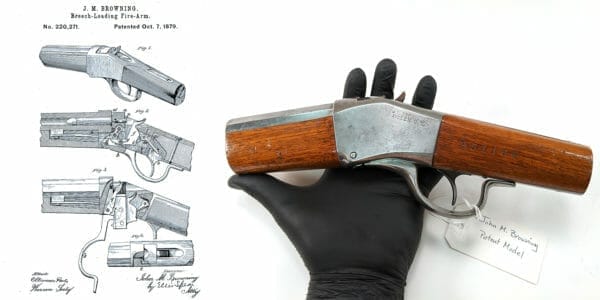
Utah– -(AmmoLand.com)- On October 7, 1879, John Moses Browning was issued US patent number 220,271 for a breech-loading firearm. It was the first of more than 120 arms-related patents that would be issued to Browning until his death in 1926.

That first patent had its beginnings a year earlier, in 1878, when John Moses was working as a gunsmith for his father, Jonathan. He told his father that he could design a better gun than the one he had been tasked to repair, and his father essentially told him to put his money where his mouth was. And so he did.
In less than a year, the design and prototype for Browning’s first gun had been completed. It was no easy task: John didn’t have access to a milling machine, so all of the work was done on an anvil and refined with files. Then, of course, he had to submit the patent application. That was a process he knew nothing about, so he relied on a jobbing house in New York to put him in touch with a patent attorney. His letter to the attorney was simple: “Please tell me how to patent a gun, and oblige.”
On May 12, 1879, he submitted his patent application and a scale model. Less than five months later, he received his patent and production began on what became known as the Browning Single Shot rifle. The patent model is now part of the National Firearms Collection at the Smithsonian National Museum of American History in Washington, DC.
John, along with his brothers, began making and selling the rifle at their shop in Ogden, Utah. Over the course of the next three years, the Brownings produced 600 rifles and sold them for $25 each. Sales were good, but reach was limited. After all, this was Utah in the 1880s. With the exception of Salt Lake City, they were more than 1,000 miles from any major city.
That all changed when a Winchester salesman named Andrew McAusland stumbled upon one of the Browning Brothers’ rifles at some point in his travels in 1883. The gun he saw was serial number 463. McAusland paid $15 for the rifle and, recognizing the potential it held, sent the gun back to the company’s New Haven headquarters for examination. It was there that vice president T. G. Bennett was shown the rifle.

Almost immediately, he set out from Connecticut for Utah – a trip that would take at least five days – with instructions from his board that he was to buy the rights to the gun, whatever the cost.
Initially, John told him the cost would be $10,000. The men dickered and a deal was struck between Bennett and Browning to the tune of $8,000. Adjusted for inflation, that amounts to almost a quarter-million dollars. For that sum, Browning sold the manufacturing rights for his rifle to Winchester. They renamed it the Model 1885 and produced it in a dizzying number of calibers.
The rifle’s single-shot, falling-block design was a hit with target shooters of the era. Not only were they very accurate, the gun’s action was one of the most solid ever designed. This meant that it could certainly handle small rimfire calibers in its Low Wall configuration, but it was able to easily withstand large calibers like the .50-90 Sharps in its more robust High Wall configuration.

When production halted in 1920, some 140,000 Model 1885 rifles had been sold. That works out to 4,000 rifles per year for 35 years. Quite the improvement from the brothers’ output of 200 handmade rifles per year.
About Logan Metesh
Logan Metesh is a historian with a focus on firearms history and development. He runs High Caliber History LLC and has more than a decade of experience working for the Smithsonian Institution, the National Park Service, and the NRA Museums. His ability to present history and research in an engaging manner has made him a sought after consultant, writer, and museum professional. The ease with which he can recall obscure historical facts and figures makes him very good at Jeopardy!, but exceptionally bad at geometry.

